8004 AN IMPORTANT VERRE ÉGLOMISÉ OVERMANTEL MIRROR, THE CARVED FRAME ATTRIBUTED TO THOMAS AND RENÉ PELLETIER, WITH A PAINTED SECTION POSSIBLY REPRESENTING AN ALLEGORY OF THE REIGN OF WILLIAM III OF ENGLAND English. Late Seventeenth Century. Measurements: Height: 73″ (185cm) Width: 56 1/2″ (144cm) Depth: 2″ (5cm)
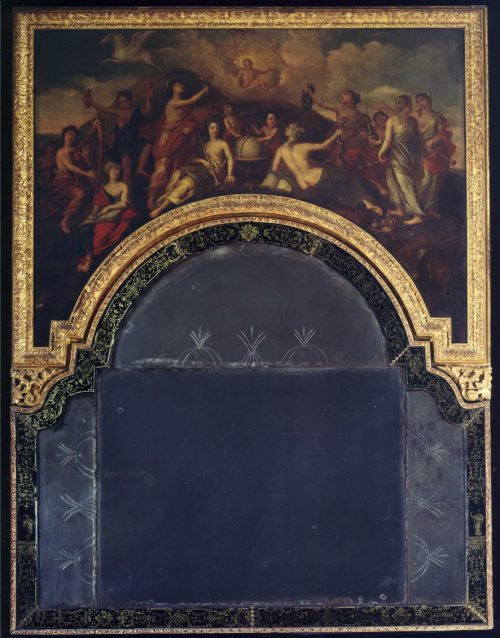
Research
The upper section of carved acanthine giltwood set with an oil painting depicting a scene of Apollo and his muses on Mount Parnassus. The lower section of black verre églomisé, the central rectangular plate flanked by engraved border plates and surmounted by a later engraved arched plate, the verre églomisé surround decorated with foliate strapwork and figures of jesters.
Published:
Tessa Murdoch, “Jean, René and Thomas Pelletier, a Huguenot family of carvers and gilders in England 1682-1726. Part 2,” The Burlington Magazine, June 1998, p 369.
Provenance:
A Swiss private collection
This remarkable object combines the creativeness of three different expert makers: a decorative painter, a carver and gilder, and a glass and églomisé worker. In each of these aspects it demonstrates the very height of design and execution. This highly effective blending of different materials suggests the overarching supervision of an interior architect, and indeed this mirror is a rare survival from the late seventeenth century, when decoration and furnishings within the interior were first being conceived of as a whole in Britain, and were reaching groundbreaking levels of cohesiveness and sophistication. That the painted section features a depiction of what is clearly an English crown, scepter and orb (see detail, page 21) encourages us to conclude that the painting shows an allegory of the reign of King William III of England (1650-1702, reigned 1689 to 1702) comparing the king to Apollo, god of light, the sun, music and art. This, along with the apparent involvement of designers and craftsmen who are known to have worked for William III and his inner circle, strongly suggests it was a member of the royal family or a fashionable supporter of the king who commissioned the piece.
It is significant that it is clearly St. Edward’s Crown, named after England’s ancient saintly king Edward the Confessor (c. 1003-1066), that has been depicted here. The original crown, said to have been worn by Edward himself, was melted by Oliver Cromwell during the English Republic in the 1650s, while the new version shown here was created on the orders of Charles II at the restoration in 1660. It is the most unchanging and symbolic of English crowns, and is recorded as being used at the moment of crowning at William III’s coronation. Its added meanings of legitimacy, succession, and tradition make a clear statement in this painted allegory of the reign of William III, a foreign king who had seized power in the bloodless Glorious Revolution of 1688.
The mirror is in a format that is the hallmark of Daniel Marot (1661-1752), architect and designer to the king. His was a distinguished and brilliant career. He trained by engraving the designs of Louis XIV’s premier decorator Jean Bérain (1637-1711) and had worked in the atelier of the famous ébéniste Andre Charles Boulle.1 He was a French Protestant or Huguenot, and had been forced to flee France in 1685 to the safety of the Netherlands where he was able to bring the glories and splendor of Louis XIV’s Versailles to the court of the appreciative Stadtholder William of Orange, the future king William III. In 1688, after William and Mary were proclaimed king and queen in England, Marot came to London and stayed for four years. He published his first collection of designs in 1690 entitled Nouvelle cheminées à panneaux de glace, à la manière ‘d France. As the name suggests, this was a compendium of designs for mirrors above fireplaces in the French style, and some designs from the book closely resemble the appearance of the present piece (figure 1). Marot was active in helping Queen Mary display her legendary collection of blue and white oriental porcelain. A later compendium of Marot designs, Nouvelles Cheminée faitte en plusier en droits de la Hollande et autres Prouinces of 1703, helps us to imagine the sort of interior into which the present piece was intended to fit.
Dr. Tessa Murdoch of the Victoria and Albert Museum states that the mirror’s exquisitely carved giltwood frame is attributed to Thomas and René Pelletier, who, together with their father Jean, were the leading carvers and gilders in London in the 1690s and 1700s.2 René likely also possessed the skills to perform verre églomisé decoration. Like Marot, the Pelletiers were Huguenots and thus were well-versed in the language of French decoration. Familiarity with decorative pattern books available at the time, such as Dessins de Divers Ornemens et Moulures Antiques et Moderne by Nicolas Langlois published in 1660, is apparent in their work. Like many highly skilled Huguenot craftsmen they gained much custom from Ralph Montagu, 1st Duke Montagu (1638-1709) who had acted as Charles II’s ambassador to the magnificent court of Louis XIV at Versailles. In the first instance Montagu employed the Pelletiers to work on his splendid London home Montagu House in Bloomsbury in the late 1680s, and later secured important royal commissions for them via his position as Master of the Great Wardrobe, a post he was awarded twice, during the reigns of Charles II in 1671 and William III in 1689.3 In 1690 the Pelletiers gilded a screen and a chimney frame in Queen Mary’s apartments at Kensington Palace, and between 1699 and 1702 they received a commission to produce over £600 worth of giltwood furniture for William III’s State Apartments at Hampton Court.
The painted section of the present piece appears to have been conceived as an allegorical decorative work, much in the same style as those pioneered at the Palace of Versailles in the 1670s under the stewardship of the director of the French académie royale de peinture et de sculpture, Charles le Brun (1619-1690). This mode of painted decoration was brought to England in 1670 with Montagu’s introduction of Antonio Verrio (1636-1707) who had worked under Le Brun.4 Verrio was accompanied by a cohort of his own assistants, many of whom would go on to have important careers in England in their own right. In particular Louis Laguerre, who had been employed at Versailles and was the godson of Louis XIV, came to England in 1684 when he was just 21 years old to work with Verrio, and started on his own three years later. He would become the most successful decorative painter in England at the beginning of the eighteenth century; his style is characterized by French classicism, which contrasts starkly with Verrio’s Italian baroque. It is into the former category that the present piece falls, increasing the likelihood that it is by a French hand, although exactly whose remains yet to be established.
The present painting represents Apollo and the Muses on Mount Parnassus. Apollo was the god of the sun who rode his chariot across the sky during the course of each day; here he is shown in this guise emerging from the clouds. The god was the protector of the Muses, each of whom symbolized a different branch of learning or the arts. They presided over the sacred springs of inspiration, created when the winged horse, Pegasus, struck the side of Mount Helicon with his hoofs. The muses were entrusted with the care of the horse and he is portrayed at the top left of the painting. The depiction of this scene had been fashionable ever since Raphael included his Parnassus in the Vatican’s Stanza della Segnatura in 1511 painted for pope Julius II. Several other renditions of the scene of particular fame have been created; a later one painted by Anton Raphael Mengs in 1761 has been viewed as heralding the beginning of the neo-Classical era. However, in both of these depictions Apollo is shown with his lyre in his role as the god of music, in contrast to the present piece where he is seen in his guise of the god of the sun. The usage of the solar Apollo bears some similarity to Louis XIV of France’s use of the god as a symbol of regal power and glory. However, the present painting’s fascinating inclusion of a set of English royal regalia must represent the symbol of the sun god Apollo being applied to an English monarch, most likely Louis XIV’s arch-rival, William III.
Although William generally identified more actively with Hercules as a classical symbol, in fact there are other examples of him invoking Apollo, such as in an armorial tapestry in the Metropolitan Museum of Art in New York, which was part of a prestigious sixteen-piece set ordered by the king himself in the late 1690s (figure 2).5 In this tapestry we can see William’s crown being held aloft by both Hercules and Apollo. The sun god’s association with Louis XIV might have added to his appeal for William III who spent much of his career at war against the French king; Apollo may have been selected as an act of defiance against his rival. Beyond the visual arts there are numerous examples of the comparison of William to the god in the literature of the period, especially in the work of the poet Matthew Prior (1664-1721). His Second Ode of the Third Book of Horace of August 1692, which praises William’s victories over Louis XIV of France, includes the following stanza that clearly compares the king to Apollo: “…in His Constellation he Unites / Their scatter’d Rays, and fainter Lights: / That His full glory shall forever Shine, / Sublime its Sphere, its ray Divine.”6 Prior would also write his appropriately titled Hymn to the Sun, which was set to music by Henry Purcell and performed for William and Mary on New Year’s Day in 1694,7 in which he addressed the king in similar terms.8
Given the involvement of the Pelletiers, the clear influence of Marot, and the subject matter of the painting, it is likely that the original commissioner of this mirror must have been William III himself, a relative, or an enthusiastic supporter who had access to the same craftsmen and designers as the king. A candidate could be the aforementioned Duke of Montagu, who expended remarkable amounts of money and effort in the 1690s to impress William with the hope of being elevated to a Duke.9 Aside from the Pelletiers and other craftsmen, he was also instrumental in bringing many other Continental decorative painters to England, including, most impressively, Charles de la Fosse (1636-1716), who painted the salon of his London home, Montagu House, with a rendering of the Assembly of the Gods on Mount Olympus, a subject similar to that seen on the present piece. The house also featured landscapes by Jacques Rousseau (1630-1693) and fifty overdoor paintings by the renowned flower-painter Jean Baptiste Monnoyer (1636-1699), which were surrounded by molded frames carved by the Pelletiers. Likewise, the Pelletiers did much work at Montagu’s country residence, Boughton House in Northamptonshire; the carving of the present piece’s frame compares very closely with a number of frames at the house supplied by Jean Pelletier in 1702, such as one that surrounds a Still Life with Flowers by Monnoyer, now in the Egyptian Hall.10 It has a semi-circular in-curve on the lower edge and would have been fitted above a mirror in a fireplace like the present example (figure 3). Through the offices of Montagu many of these artists also worked for William III and his wife Mary II. Monnoyer, for example, is recorded as decorating a mirror at Kensington Palace for the queen with “her Majisty sitting by him almost all the while,”11 and many of Rousseau’s landscapes remain at Hampton Court Palace. Although de la Fosse would travel back to Paris directly after finishing at Montagu House to paint the interior of the dome at Les Invalides, many other members of the group stayed in England and worked for William III and his circle. It is distinctly likely that one of them produced the painted section of the present piece.
Another possible candidate as original commissioner of this object is Arnold van Keppel, 1st Earl of Albemarle (1670-1718) who, after the death of Queen Mary II in late 1694, attained an unrivaled position as the king’s favorite. In 1695 he became both his Groom of the Bedchamber and Master of the Robes, and in 1700 was the recipient of an unprecedented gift of £50,000 from the king.12 He was given lodgings at Hampton Court Palace that adjoined the kings apartment, which were fitted out at great expense. It is possible that the present piece could have been commissioned for these rooms. Alternatively, it could have been made for his exquisite Dutch home, the Huis de Voorst, not far from William’s palace, Het Loo, on which Daniel Marot worked directly as designer with the architect Jacob Roman (1640-1716). Marot published some of the work he did at the house in his design collections and there is evidence that several of the same artists who worked for the king and Montagu were employed there. Keppel fought by the side of the Duke of Marlborough against the forces of Louis XIV during the War of Spanish Succession, and would have perhaps liked to have a painting of his patron and friend William III as Apollo in the place of his enemy.
The final important element of the present piece is its glass. The mostly original, decoratively beveled mirror plates are a remarkable survival. A band of black and gold verre églomisé decoration surrounds the plates; this technique, at the time called “mosaic work” was especially fashionable in the years around 1700. In this instance, it was likely executed by René Pelletier himself, “whose training and experience as a ‘graveur’ or engraver would have equipped him to undertake such detailed and figurative work.”13 Here, amongst the strapwork decoration on the verre églomisé, are two figures on each side; a mirror in a similar format with closely comparable figures was illustrated in The Mirror Book by Herbert F Schiffer (figure 4). Such figures appear to be heavily influenced by the work of ornamental artists working for Louis XIV, such as Jean Berain the Younger (1637-1711) and Jean le Pautre (1618-1682). Two mirrors in the collection of the Victoria and Albert Museum of a slightly later style, which are also attributed to the Pelletiers, display comparable verre églomisé decoration also incorporating figures (figures 5 and 6). The earliest documentary evidence of the Pelletiers’ usage of this decoration dates from 1705 when they produced a mirror for a chimneypiece at Montagu’s country seat, Ditton, in Buckinghamshire, however, it remains possible they were employing it earlier.14
The present piece dates from an age when mirror glass was astronomically expensive, owing to the remarkably complex blowing, cutting and silvering techniques used at the time. At the end of the seventeenth century the production of mirrors in England was led by two competing London factories, the Bear Garden and the Vauxhall works. The diarist John Evelyn visited the latter factory in 1676 commenting that its glass was “far bigger and better than any that came from Venice.”15 This mirror glass was the premier product of the industry of the time, and was made either by the Lorraine process, the blowing of a long cylinder, which was then cut, or it was cast using a technique invented by the French glassmaker Bernard Perrot in 1687. Levels of clarity and size were points of competition between factories; in 1700 the Vauxhall works advertised “large looking glass plates, the like never made in England before…with rough plates from the smallest sizes to those six foot in length,” whilst in 1702 the Bear Garden promised glass plates up to 90 inches across “free from veins and foulness.”16 It is highly likely that the glasswork on the present piece was originally produced in one of these factories. This material was so expensive that even the wealthiest of owners would often have old panes reworked sooner than buy new ones. In 1699 the cabinet maker Gerrit Jensen supplied a large mirror plate to insert into a magnificent silver mirror made for William III by the silversmith Andrew Moore for £100, a huge sum of money.17 The present piece, with its verre églomisé, may have cost a similar amount, and the additional expense of the giltwood frame and the finely painted upper section would have made this object an adornment of the most expensive and luxurious kind.
Footnotes:
1. Graham Child, World Mirrors, Sotheby’s 1990, p. 66
2. Tessa Murdoch, “Jean, René, and Thomas Pelletier, a Huguenot family of carvers and gilders in England 1682-1726. Part 2,” The Burlington Magazine, June 1998, p 369.
3. Edward Charles Metzger, “Montagu, Ralph, first duke of Montagu (bap. 1638, d. 1709),” Oxford Dictionary of National Biography, Oxford University Press, 2004,
4. Edward Croft-Murray, Decorative Painting in England, London 1962, vol. 1, p. 250
5. Edith Appleton Standen, European Post Medieval Tapestries and Hangings in the Metropolitan Museum of Art, Volume Two, New York 1985 p. 226
6. Matthew Prior, An ode in imitation of the second ode of the third book of Horace by Mr. Prior, London 1692
7. Samuel Humphries, The Poetical Works of Matthew Prior, Volumes 47-48, p. 40
8. Ibid. The verse is as follows: Light of the World, and Ruler of the Year, / With happy Speed begin / Thy great Career; / And, as Thou dost thy radiant Journeys run, / Through every distant Climate own, / That in fair Albion Thou hast seen / The greatest Prince, the brightest Queen, / That ever sav’d a Land, or blest a Throne, / Since first Thy Beams were spread, or Genial Power was known8
9. Metzger op. cit., (Montagu even built a state apartment to accommodate the king at Boughton that William III used in 1695, it remains one of the best preserved such apartments in England. He was eventually made a Duke by William’s successor Queen Anne)
10. Tessa Murdoch, “Jean, René, and Thomas Pelletier, a Huguenot family of carvers and gilders in England 1682-1726. Part 1,” The Burlington Magazine, Nov 1997, p. 741
11. Edward Croft-Murray, op. cit., p. 67
12. James Falkner, ‘Keppel, Arnold Joost van, first earl of Albemarle (1669/70–1718)’, Oxford Dictionary of National Biography, Oxford University Press, 2004
13. Murdoch, op. cit., p. 369
14. Ibid.
15. Child, op. cit. p. 19
16. Ibid., p. 90.
17. See Royal Collection 35302.
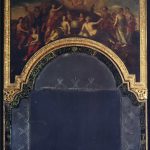
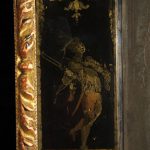
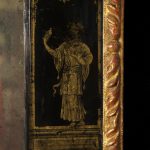
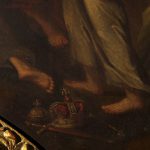
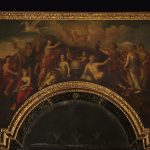
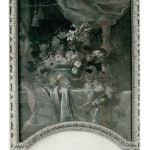


Comments are closed.